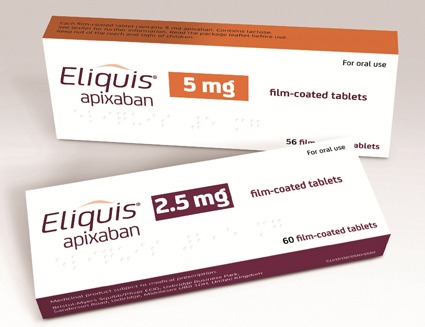Apixaban Anticoagulant Monitoring
 Apixaban Assay Sample Submission FAQ
Apixaban Assay Sample Submission FAQ
- What sample is required for apixaban assay?
- How long after treatment should I draw samples for apixaban assay?
- What is the test code, turnaround time, and cost for apixaban assay?
- What is the shipping address for apixaban assay?
What sample is required for apixaban assay?
Separated citrate plasma (plasma from a blue top tube) is the only valid sample. DO NOT SUBMIT SERUM. Request test code APBN and ship at least 0.5 mL plasma in an insulated box with cold packs for overnight delivery. See the sampling page for detailed sampling instructions.
How long after treatment should I draw samples for apixaban assay?
Draw samples 4 to 6 hours after oral apixaban administration. Pharmacokinetics of this drug in companion animals are not yet well-defined, however preliminary data indicate that peak anticoagulant activity is expected at approximately 4 hours (cats) and 5 to 6 hours (dogs) post-dose.
What is the test code, turnaround time, and cost for apixaban assay?
Use test code "APBN" and indicate apixaban therapy on the AHDC general submission form. Assays are performed daily (Monday thru Friday) and results reported within 24 hours of sample receipt. Refer to the AHDC test/fee list for current pricing.
What is the shipping address for apixaban assay submission?
FedEx/UPS/Courier Address:
Comparative Coagulation Section/AHDC
College of Veterinary Medicine, Cornell University
240 Farrier Road
Ithaca, NY 14853
US Postal Service Address (PO Box):
Comparative Coagulation Section/AHDC
College of Veterinary Medicine, Cornell University
PO Box 5786
Ithaca, NY 14852-5786
Apixaban Assay and Monitoring FAQ
- How can I use the apixaban assay to guide therapy?
- What is the target range concentration for apixaban therapy?
- What are the clinical uses of apixaban?
- Is the apixaban assay different than the heparin or rivaroxaban assays?
- Does apixaban affect coagulation assays (APTT and PT)?
- Can I use the apixaban assay to monitor rivaroxaban?
How can I use the apixaban assay to guide therapy?
The apixaban assay measures drug levels based on its bioactivity as an inhibitor of Factor Xa (anti-Xa assay method). Measuring apixaban bioactivity will allow dose adjustment to prevent too much anticoagulant effect and risk for bleeding, or no anticoagulant action and inadequate therapy.
What is the target range concentration for apixaban therapy?
Disease-specific apixaban therapeutic target ranges have not yet been established in human or veterinary medicine. Peak values observed for humans on low dose apixaban range up to 150 ng/mL, with peak values for higher intensity therapy of approximately 300 ng/mL.
What are the clinical uses of apixaban?
The current indications for apixaban (Eliquis) in human medicine include thromboprophylaxis for orthopedic surgery, the treatment of deep vein thrombosis and pulmonary thromboembolism, and to prevent thromboembolic disease in patients with non-valvular atrial fibrillation. Safe and effective dosages have not yet been defined for thrombotic disease in dogs or cats. Pharmacokinetic studies in dogs and cats have investigated dosages of 0.2 mg/kg.
Is the apixaban assay different than the heparin or rivaroxaban assays?
The assay methodology for these anticoagulant drugs is based on inhibition of Factor Xa (anti-Xa), however each assay uses a drug-specific calibrator and controls. The assays are NOT interchangeable and a specific test request is required based on the relevant drug.
Does apixaban affect coagulation assays (APTT and PT)?
Patients receiving apixaban may have mild to moderate prolongation of clotting time tests beyond reference range, however the degree of prolongation is variable among patients. A marked prolongation of clotting time may be an indicator of excessive anticoagulant action and risk for abnormal bleeding.
Can I use the apixaban assay to monitor rivaroxaban ?
Rivaroxaban (Xarelto) and apixaban (Eliquis) are different drugs, although both have a similar mechanism of anticoagulant action.
Use the specific test code APBN (apixaban) for apixaban monitoring and code RIVA (rivaroxaban) for rivaroxaban monitoring.


